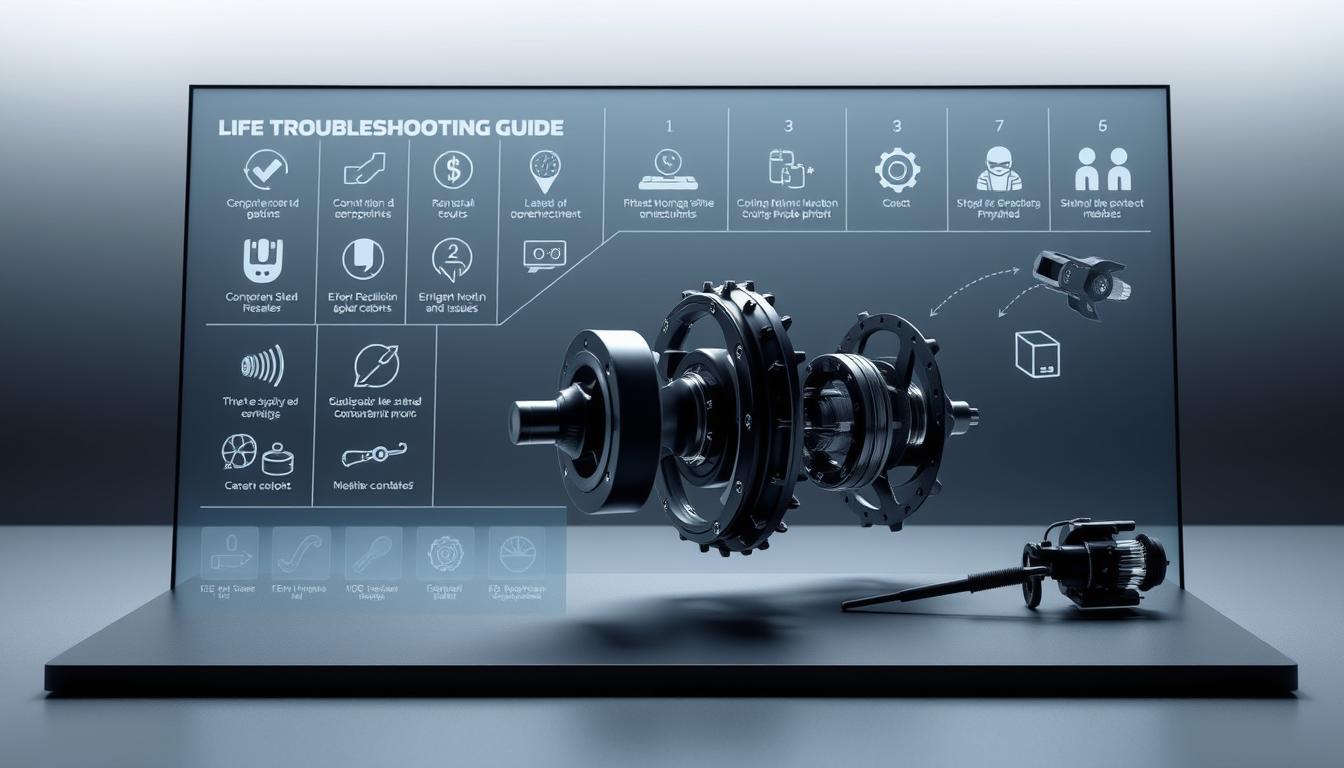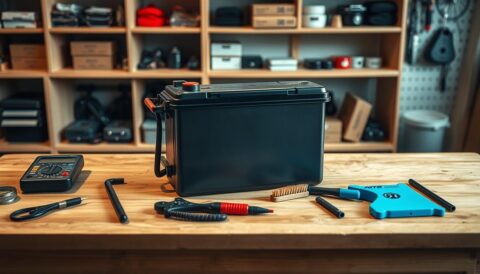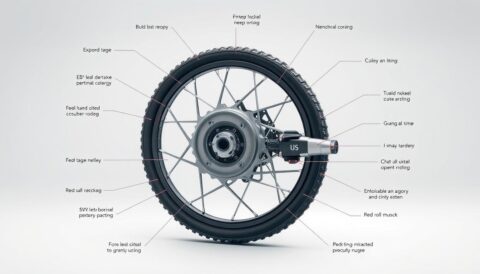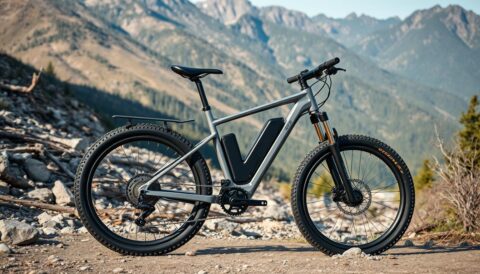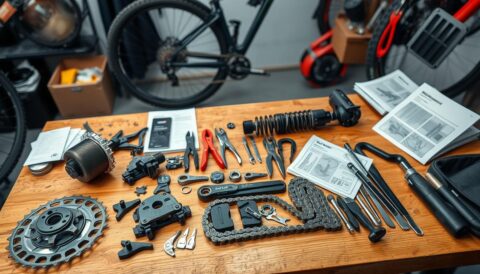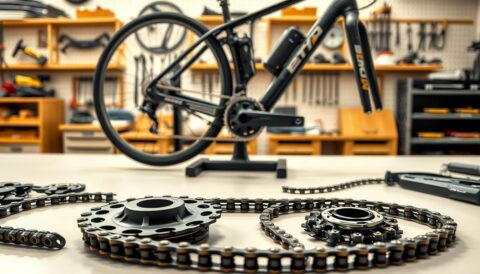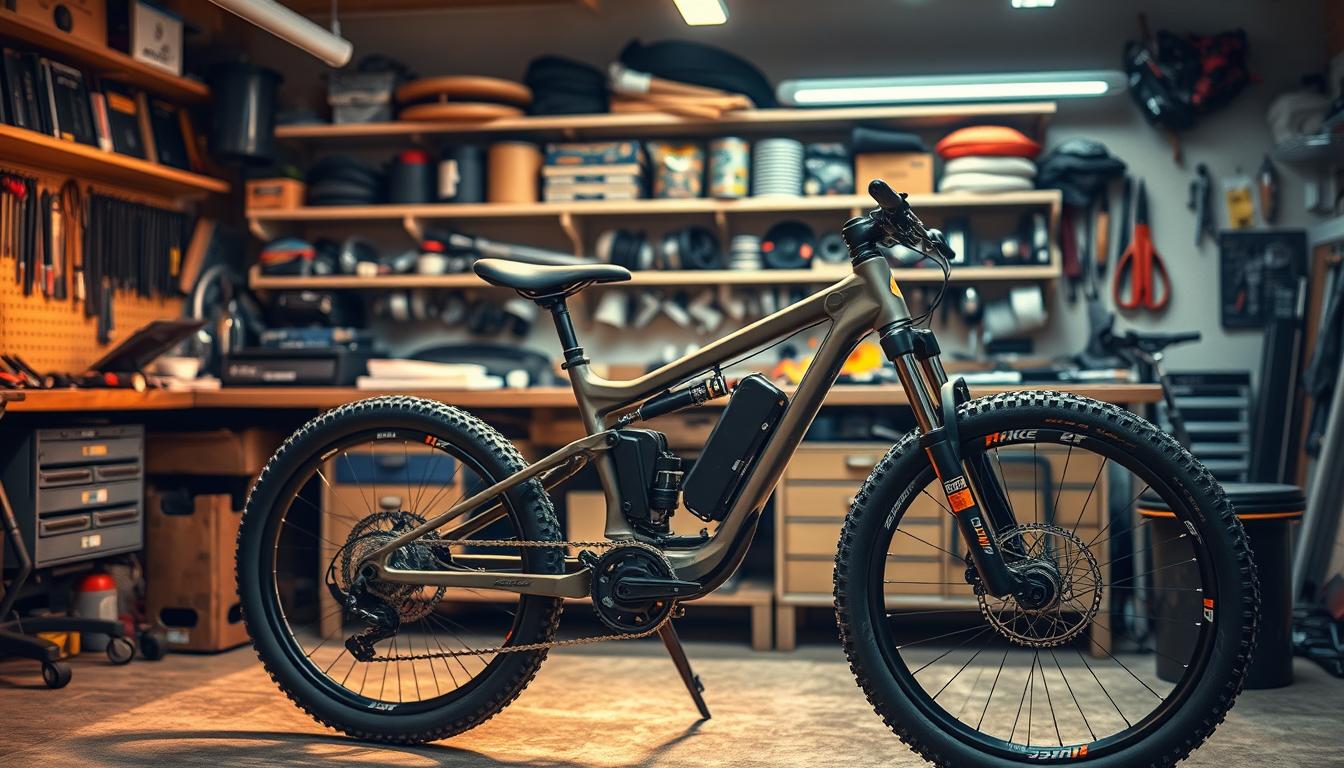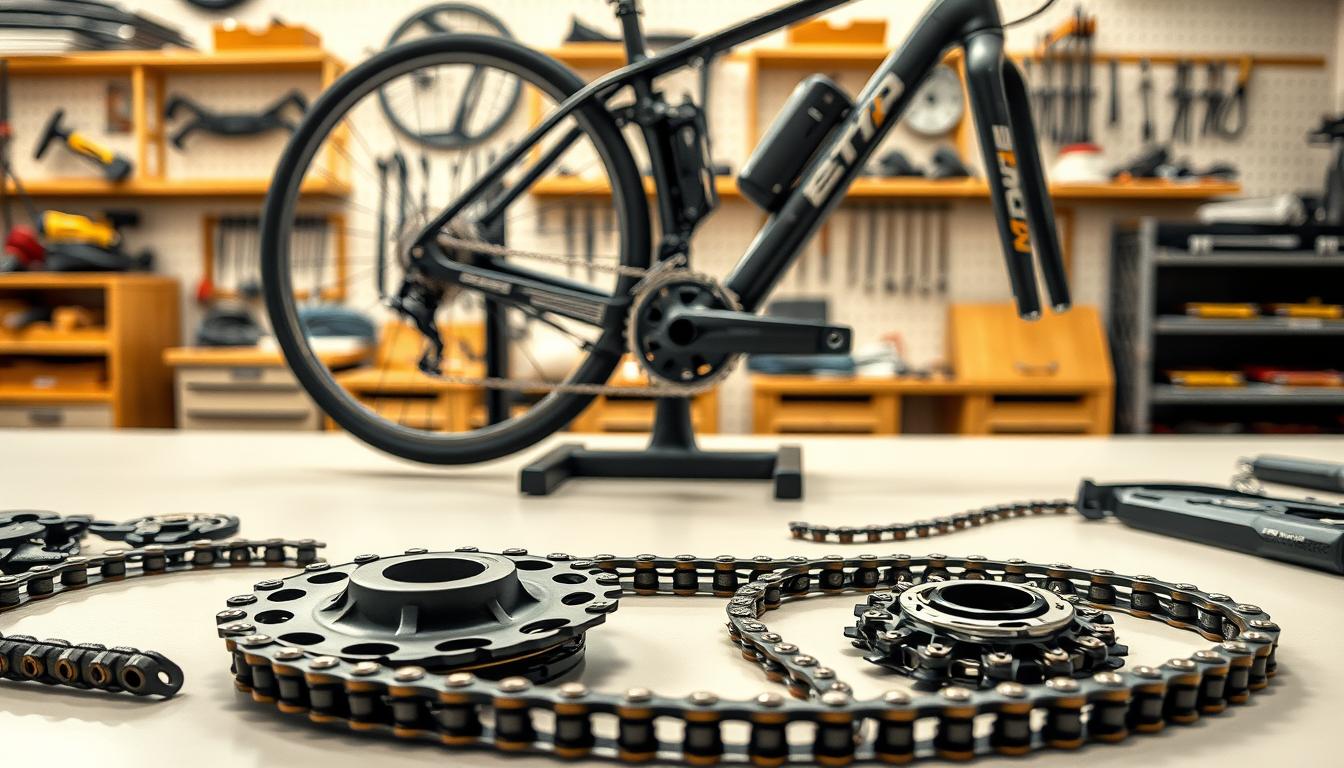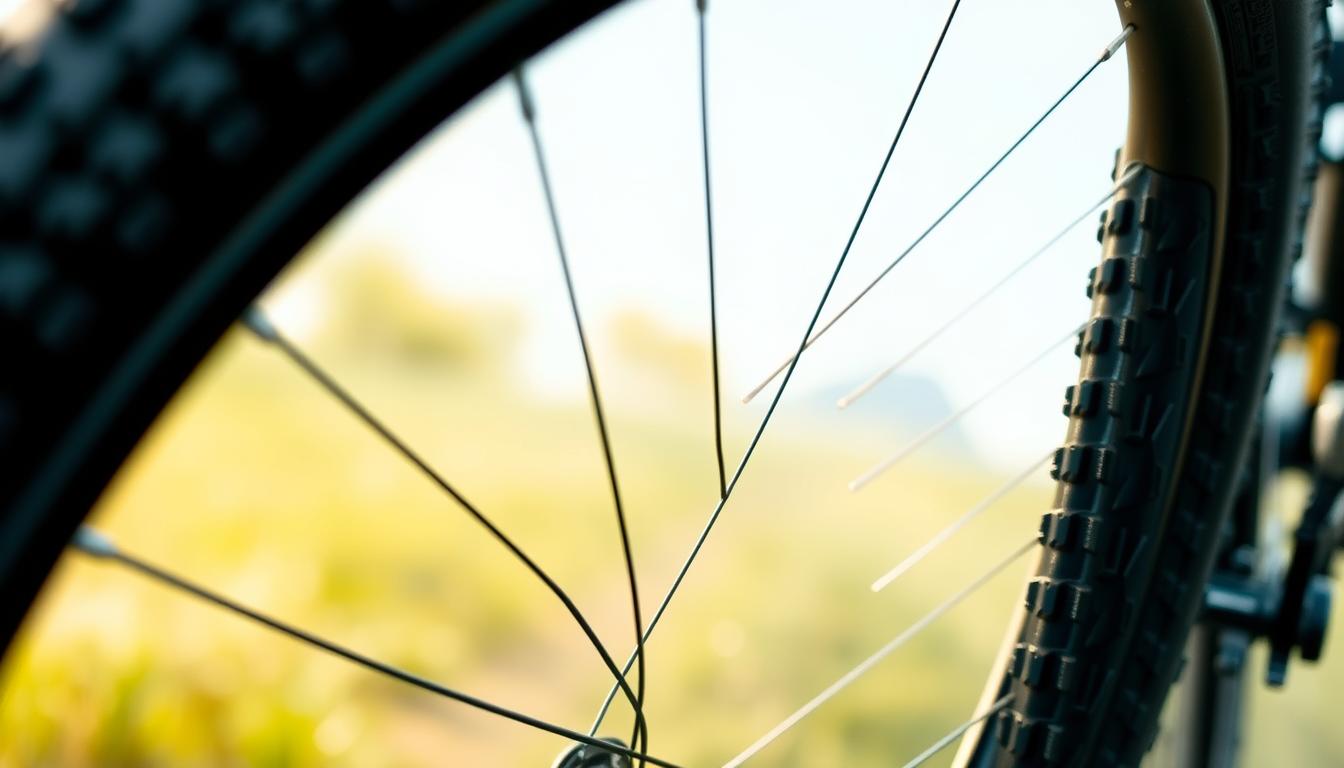Electric mountain bikes (E-MTBs) are advanced machines that mix technology with tough cycling. Knowing how your electric mountain bike motor works is key for fixing problems and keeping it in top shape1.
Many riders face issues with their electric bikes, like battery problems or motor issues. These complex machines can surprise even seasoned cyclists1. Issues include damaged wheels, unstable rides, and electrical failures1.
Wheel problems are common among E-MTB users. They might get punctures, feel unstable, or have wheels lock up without warning1. These issues can ruin your ride and even be dangerous, affecting up to 25% of electric bike users1.
Battery troubles are another big worry. About 40% of e-bike owners have battery issues, like charging problems or shorter battery life1. Taking good care of your battery can help avoid these problems2. With proper care, electric bike batteries can last 3 to 5 years2.
Electrical system issues can also be tough to deal with. Problems like loose connections, faulty sensors, and wiring issues can mess with your motor’s performance1. Riders might see error codes, with some bikes having connection issues in 5-10% of cases1.
This guide aims to give you detailed help with E-MTB motor troubleshooting. By understanding your electric mountain bike’s complex systems, you can keep it running smoothly and make it last longer.
Understanding E-MTB Motor Basics
Electric mountain bikes (E-MTBs) mix old-school cycling with new tech. They use special parts that change how you ride3.
There are many types of electric bike motors. Each one offers different ways to ride. At the heart of these motors are brushless DC (BLDC) motors. They’ve been top-notch for over 10 years because they’re super efficient3.
Core Motor System Components
An E-MTB motor system has key parts:
- Motor unit
- Battery pack
- Controller
- Sensor systems
Motor Functionality and Performance
It’s important to know how electric bike motors work. Mid-drive motors work best when you pedal between 50 to 80 RPM. This makes riding easier3.
Motor System Variations
There are two main types of electric bike motors:
- Hub Motors
- Mid-Drive Motors
- They’re more complex
- They cost more3
E-bikes also have different classes based on their motors:
- Class 1: Pedal-assist only, 20 mph max
- Class 2: Pedal-assist with throttle, 20 mph max
- Class 3: Pedal-assist up to 28 mph3
Knowing about E-MTB motor parts and types helps riders choose the right bike.
Battery Power and Charging Issues
Fixing electric mountain bike (E-MTB) battery problems is key to keeping your bike in top shape4. The battery is a big investment, with new ones costing over £1,000. So, taking good care of it is vital5.
When dealing with electric bike charging issues, several important factors come into play. Battery health relies on regular upkeep and careful charging4. Here are some key points for E-MTB battery care:
- Charge the battery at least once a month to prevent deep discharge4
- Store the battery at 30-60% charge during extended periods4
- Avoid charging in extreme temperatures5
- Regularly inspect the battery for physical damage4
Knowing how long your battery will last is important for E-MTB owners. With the right care, batteries can last 3 to 5 years5. Common problems include:
- Reduced battery capacity over time
- Charging time irregularities
- Voltage inconsistencies
Regular maintenance can help your battery last longer. Experts say not to overcharge and watch the battery to avoid damage4.
Remember, looking after your battery well is key. It keeps your electric mountain bike running smoothly and ready for tough trails5.
E-MTB Motor Troubleshooting Guide
Electric mountain bikes sometimes face motor problems that need careful checking and fixing. Knowing how to tackle these issues can save riders time, money, and stress on their rides.
When looking into electric bike motor issues, riders should have a clear plan to find and fix problems. A few key steps can keep the motor running well and avoid damage.
Common Error Codes and Their Meanings
E-MTB error codes are key to spotting motor troubles. It’s important for riders to know how to read their bike’s error codes. Common codes might show:
- Battery voltage issues6
- Sensor connection problems6
- Internal motor circuit damage6
- Electrical system breaks
Motor Performance Diagnostics
Good electric bike motor checks involve several steps:
- Check battery voltage6
- Look at sensor connections6
- Listen for odd motor sounds
- Watch for sudden power drops
When to Seek Professional Help
Some motor problems need expert help. Riders should get a pro if they see:
- Stuck error codes6
- Internal motor circuit failures6
- Hard electrical system issues
- Issues that won’t go away
Safety first: Always choose professional help for tricky motor checks.
Knowing your E-MTB’s motor system helps you keep it running at its best. It also makes your electric mountain bike last longer.
Motor Connection and Wiring Problems
Electric mountain bikes (E-MTBs) have complex electrical systems. Issues with E-MTB wiring can turn a smooth ride into a frustrating one. It’s important to understand electric bike connection problems to keep your bike running well7.
Electrical connections in E-MTBs face many challenges. Loose or damaged wires can come from:
- Trail vibrations causing wire disconnection
- Corrosion at connection points
- Impact damage during riding
- Improper initial installation
Spotting wiring problems needs a careful look. Key areas to check include:
- Motor-to-controller connections
- Battery terminal interfaces
- Sensor wire integrity
- Brake motor inhibitor links
Motor circuit failures can be caused by many electrical issues. These include wire breakage, short circuits, and loose connections7. It’s vital to check for damaged wiring to avoid motor performance problems8.
| Connection Type | Common Issues | Recommended Action |
|---|---|---|
| Battery Terminals | Corrosion, Loose Connections | Clean and Tighten Connections |
| Motor Wiring | Wire Damage, Fraying | Inspect and Replace if Necessary |
| Sensor Connections | Signal Interference | Check Alignment and Integrity |
Regular maintenance can stop most E-MTB wiring issues. Do regular visual checks, make sure wires are properly routed, and fix any wear signs right away8.
Temperature-Related Motor Issues
Keeping your electric mountain bike at the right temperature is key. E-MTB motor overheating can ruin your ride and harm important parts9.
When it’s cold, electric bikes face special challenges. It’s important to know how to keep them safe. Shimano gives clear guidelines for the best motor performance10:
- Safe charging temperature range: 0 to 40ºC
- Operational temperature range: -10º to 50ºC
- Optimal battery storage temperature: Around 20ºC
Overheating Prevention Strategies
To stop E-MTB motor overheating, you need to act early. Look out for excessive heat and unusual burning smells9. Here are some ways to prevent it:
- Avoid direct sunlight exposure
- Use cooling pads to absorb excess heat
- Allow motor to cool before charging
- Invest in heat-resistant protective covers
Cold Weather Riding Tips
In cold weather, your battery might not work as well. To get the most out of it, follow these tips10:
- Charge battery between 20% and 80% capacity
- Charge just before riding
- Avoid completely draining the battery
Temperature Sensor Diagnostics
Modern e-bikes have advanced temperature systems. Smart thermometers can warn you of overheating9. This helps keep your electric mountain bike safe and sound.
Pedal Assist System Malfunctions
Electric mountain bike riders often face issues with their pedal assist system (PAS). This can really affect how well they ride11. It’s key to know about these problems to keep your bike running smoothly12.
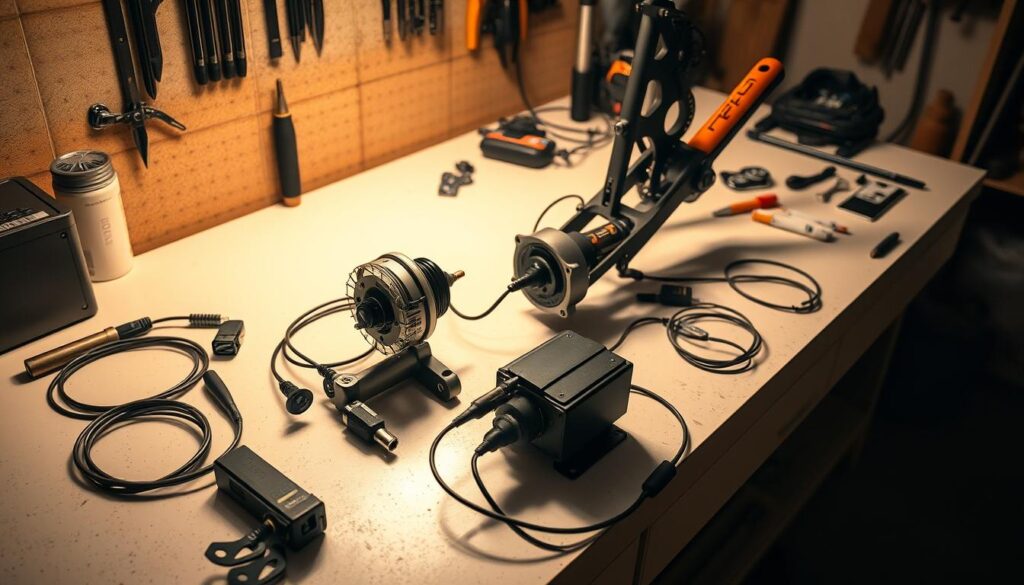
The pedal assist system has two main parts: the sensor and the magnet wheel12. Riders might run into a few common problems when trying to fix their electric bike’s PAS:
- Sensor not lining up with the magnet11
- Issues with the battery connection11
- Wiring problems11
- Glitches in the control system’s software11
Different sensors, like cadence and torque, can change how the pedal assist works13. A bit of delay when it starts is okay, but if it keeps happening, you need to look into it13.
Here are some steps to troubleshoot your electric bike’s PAS:
- Make sure the sensor is aligned with the magnet12
- Check the battery’s charge and connections13
- Look for any damage in the wiring11
- Try resetting the system13
Pro tip: If the pedal assist sensor light doesn’t turn on, it could mean a power problem or a broken sensor12. For tricky electrical issues, it’s best to get help from a pro11.
Controller-Related Problems
The controller is the brain of your electric mountain bike. It controls all electrical functions. Knowing how to fix E-MTB controller issues can stop ride problems and keep your bike running well electric bike diagnostics.
Many things can cause electrical problems. It’s important to check everything carefully. For example, if the voltage doesn’t match, the motor might stop too soon14. Also, if connections are loose, you might lose power while riding14.
Display Unit Diagnostics
Display issues can show up as weird error messages or a screen that won’t work. To fix these, you should:
- Check the cables
- Make sure the power is on
- Look for any damage on the screen
Control Panel Assessment
Checking the control panel can help find electrical problems. Look out for:
- Buttons that don’t work right
- A screen that flickers
- Unexpected changes in mode
Software Updates and System Resets
Keeping your controller’s software up to date is key. It helps avoid electrical issues14. Sometimes, a reset can fix problems without needing a tech.
If you can’t fix the problem yourself, it’s time to call a pro. They have the right tools to find and fix complex issues15.
Motor Noise and Vibration Concerns
Electric mountain bike riders often face motor noise and vibration issues. These can affect their riding experience. It’s important to understand the causes to keep your E-MTB running well and lasting long1617.
- Loose mounting components
- Bearing wear
- Gear misalignment
- Debris accumulation
Intermittent motor noise can be a big problem, making rides on rough terrain worse. Loose screws and bolts are often the main cause, coming loose during intense rides17. Warped bearings can make sounds during acceleration or uphill, showing mechanical stress17.
Different motor types face unique noise challenges. For example, Bafang motors might show specific noise symptoms, like more vibration under heavy loads or long use16. Users have noticed loud noises during acceleration, which could mean mechanical or electrical problems16.
Preventative maintenance helps reduce motor noise and vibration. Here are some tips:
- Regularly check motor mounts
- Look for and tighten loose parts
- Clean the motor housing to remove debris
- Lubricate moving parts correctly
Getting professional help is wise if you hear grinding or constant noises. Experts suggest getting your bike tuned up once a year to catch problems early17.
Water Damage Prevention and Recovery
Electric mountain bikes (E-MTBs) are complex machines that need careful protection from water. Water can harm your bike’s electrical parts and motor. It’s key to know how to keep your E-MTB dry to ensure it lasts long18.
Waterproofing Best Practices
To keep your E-MTB safe from water damage, follow these steps:
- Use high-quality waterproof covers during storage
- Apply protective silicone sealants on electrical connections
- Invest in water-resistant electrical component enclosures
- Clean and dry your bike thoroughly after wet rides18
Drying and Recovery Methods
If your E-MTB gets wet, act fast:
- Disconnect the battery immediately
- Gently wipe down all electrical components
- Use compressed air to remove moisture from connections
- Allow complete air drying for 24-48 hours19
Preventing Future Water Damage
To lower the risk of E-MTB water damage, take these steps18:
| Prevention Strategy | Recommended Action |
|---|---|
| Regular Inspection | Check seals and waterproof integrity monthly |
| Riding Conditions | Avoid deep water crossings and heavy rainfall |
| Storage | Store in dry, temperature-controlled environment |
Remember, prevention is always better than costly repairs for electric bike waterproofing.
Battery Management System Issues
Electric mountain bike riders often face problems with battery management systems (BMS). About 30% of e-bike users have issues with charging and battery life20. It’s important to know these issues to keep your E-MTB battery working well.
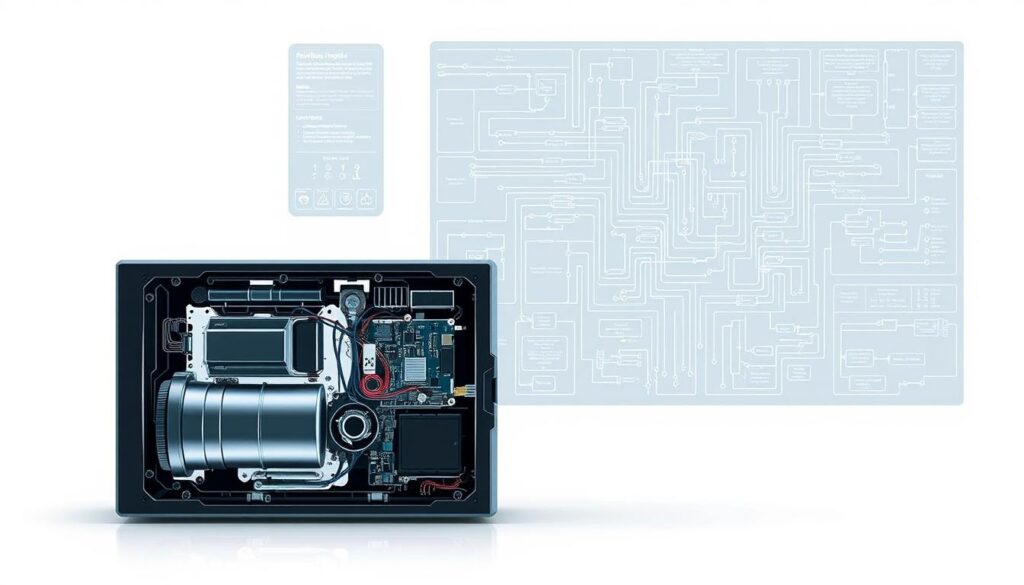
An electric bike battery usually lasts 3 to 5 years, depending on how well you take care of it21. After 2-3 years of regular use, batteries can lose up to 20% of their power. This is due to things like temperature and how you charge them20.
- Up to 10% of battery failures are because of BMS problems20
- Keep batteries charged between 40% and 80% to make them last longer21
- Don’t let batteries sit uncharged for more than six months21
Fixing electric bike BMS problems means paying attention to how you charge it. Overcharging can harm batteries, so don’t leave them plugged in for too long. Charging in very cold temperatures can also cause problems21.
Signs that your E-MTB battery management system might be failing include:
- Unusual battery readings
- Power cuts without reason
- Battery not holding its charge
- Trouble charging the battery
Proper maintenance is the key to extending your E-MTB battery’s life and performance.
By knowing about these common battery management system issues, riders can take steps to keep their electric mountain bike’s battery in good shape. This ensures they can enjoy reliable performance on tough trails.
Drive Unit Maintenance Tips
Looking after your E-MTB’s drive unit is key to keeping it running smoothly. Electric bike motor care needs a careful routine to ensure your bike stays in great shape22.
It’s vital to regularly check your electric mountain bike’s drive unit. It faces more stress than regular bikes, so it needs more attention22.
- Inspect electrical components annually22
- Clean the drive unit regularly to prevent dirt accumulation22
- Check and maintain proper component tightness22
Important maintenance steps include:
- Chain Lubrication: Apply lubricant after every ride23
- Tyre Pressure: Keep it right to boost battery life23
- Battery Care: Store it at room temperature and keep it charged between 30-60%22
Keeping your e-bike in top shape means regular safety checks and updates. These actions can make your e-bike last longer and perform better22.
Good maintenance can cut down problems by up to 70% and save a lot of money23.
| Maintenance Task | Frequency | Impact |
|---|---|---|
| Chain Lubrication | After each ride | Reduces wear, improves efficiency |
| Electrical Component Check | Annually | Prevents possible failures |
| Battery Storage | Continuous | Increases battery life by 20-30% |
Speed Sensor Troubleshooting
Electric mountain bikes need precise speed sensors for top performance. It’s important to fix E-MTB speed sensor problems to keep your bike working well24.
Speed sensors are vital for electric bikes. They measure wheel speed and talk to the bike’s control unit24. Fixing sensor issues can stop many problems.
Sensor Alignment Fundamentals
Getting the sensor aligned right is key for accurate readings. The gap between the magnet and sensor should be just right25:
- Ideal magnet-sensor gap: 3-12mm for Shimano systems
- Check sensor positioning regularly
- Ensure magnet is securely attached to wheel spoke
Common Sensor Error Indicators
Spotting speed sensor problems early can save a lot of trouble. Look out for these signs24:
- Inconsistent speed readings
- Frequent error codes
- Reduced motor assistance
- Unexpected power interruptions
Signal Interference Solutions
Things like mud and cold can mess with sensor performance24. Keep your speed sensor safe from:
- Mud and water exposure
- Extreme temperatures
- Physical damage
A well-maintained speed sensor ensures optimal electric bike performance and safety.
If you’re having trouble with your electric bike sensor, think about getting it checked by a pro25. Most problems come from wrong installation or sensor not being right25.
| Sensor Issue | Potential Cause | Recommended Action |
|---|---|---|
| No Speed Reading | Misaligned Magnet | Realign Magnet |
| Intermittent Assist | Sensor Dirt/Damage | Clean/Replace Sensor |
| Error Codes | Signal Interference | Check Wiring |
Remember: Preventative maintenance is key to long-term E-MTB performance.
Emergency Repair Procedures
Being ready for electric bike repairs is essential. E-MTBs often break down because of their heavy parts. So, knowing how to fix them on the trail is vital for mountain bike fans26. A good repair kit can turn a big problem into a small one.
Tyre troubles are common on electric mountain bike rides. A quick fix for a flat tyre is using a tire plug, which works well with tubeless tyres26. For a lasting fix, replacing the inner tube is best. Patching is cheaper and better for the environment26. If needed, you can even tie a knot in the tube to keep riding for a bit longer26.
Chain and mechanical problems can pop up without warning. Fixing a chain is cheap and fast, costing just a few euros26. For bigger issues like a broken rear mech hanger, you can swap it out in minutes with a few Allen screws26. Always have spare parts ready. Some problems, like loose battery connections, can be fixed easily with basic knowledge27.
Prevention is the best way to avoid E-MTB trail repairs. Carry the right tools, know basic maintenance, and stay calm when things go wrong. Being ready means you can turn any problem into a minor setback on your electric mountain biking adventures.
FAQ
How do I know if my E-MTB battery is degrading?
Look out for signs like a shorter range, uneven power, longer charging, and big capacity drops. If your battery doesn’t last as long or power struggles, it might need replacing or a check-up.
What are the most common motor error codes I should be aware of?
Error codes often point to temperature, connection, sensor, or battery issues. Your E-MTB’s display will show codes for these problems. Check your manual or ask a pro to understand them.
How can I prevent water damage to my electric mountain bike?
Keep electrical parts dry and sealed, use covers, and avoid deep water. Dry your bike well after rides. Treat parts with water-resistant coatings and check seals often.
What maintenance tasks are critical for my E-MTB’s drive unit?
Clean it regularly, check and adjust torque, and lubricate parts. Inspect belts and gears for wear and protect from dust and water. These steps keep your drive unit running smoothly.
How do I diagnose Pedal Assist System (PAS) problems?
Check sensor and magnet alignment, wiring, and controller settings. Look for odd assistance, power spikes, or loss of support. A simple tweak might fix minor issues.
What emergency tools should I carry on an E-MTB ride?
Carry a multi-tool, spare tube, charger, tape, cutters, ties, and a jump starter. Also, a phone, first aid kit, and repair service info are vital.
How does temperature affect my E-MTB motor’s performance?
High heat can cause motors to overheat and lose power. Cold can reduce battery life and harm components. Avoid extreme temperatures to keep your E-MTB running well.
When should I seek professional help for motor issues?
Get help for complex electrical issues, error codes, motor damage, wiring problems, or if you’re not sure how to fix it. Experts can diagnose and repair safely, avoiding more damage.
Source Links
- 20 Common Electric Bike Problems and Solutions
- Electric Bike Troubleshooting Guide | Here’s Why it’s Not Working… – E Mountain Bikes
- If You’re Considering an E-Bike, Let This Motor Guide Explain All They Have to Offer
- Electric Bike Knowledge Articles | Raleigh UK
- Electric Bike Troubleshooting Guide | Here’s Why it’s Not Working… – E Mountain Bikes
- Troubleshooting Guide: Why Your E-Bike Motor is Not Working
- Troubleshooting Guide: Why Your E-Bike Motor is Not Working
- Electric Bike Troubleshooting Guide | Here’s Why it’s Not Working… – E Mountain Bikes
- Maintaining E-bike Motor Health in Extreme Heat Conditions
- E-bike Repair and Maintenance: How to Diagnose and Solve Common Electric Bike Problems
- Electric Bike Pedal Assist Not Working: How To Fix It
- Troubleshooting Pedal Assist on an E-Bike
- The Ultimate Guide for Troubleshooting Pedal Assist System – Magicycle Bike
- E-Bike Controller Maintenance – Rydy Bikes
- The Ultimate Guide to Troubleshooting Common Electric Bike Problems
- Bafang Motor Problems: The Worst 5 Issues & How To Solve Them – Voltriderz
- E-bike Motor Making Intermittent Grinding or Chugging Noise?
- Electric Bike Troubleshooting: The Most Common Problems and Solutions – Magicycle Bike
- Ebikes Keep Cutting Out? Here Are the Solutions – Magicycle Bike
- 20 Common Electric Bike Problems and Solutions
- Electric Bike Troubleshooting Guide | Here’s Why it’s Not Working… – E Mountain Bikes
- How to maintain your electric bike, from servicing to washing electrical parts
- Top E-Bike Maintenance Tips
- Ebike Speed Malfunction | How to fix sensor error problem
- Mastering Speed Sensor Errors and Tuning Kits: A Complete Guide for eBike Riders
- 5 emergency puncture repair tips that every E-MTB rider should know
- Electric Bike Troubleshooting Guide – Rydy Bikes
